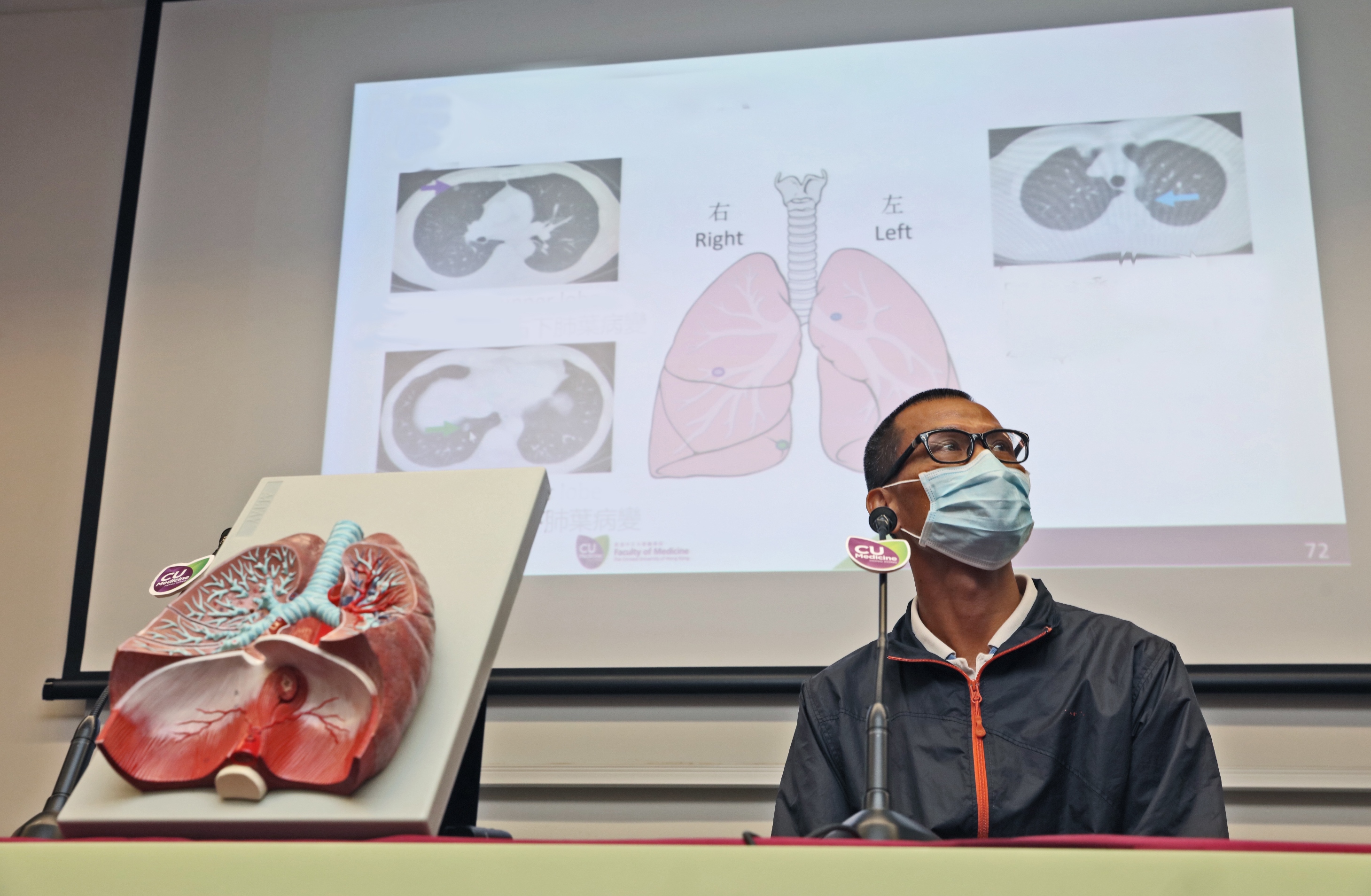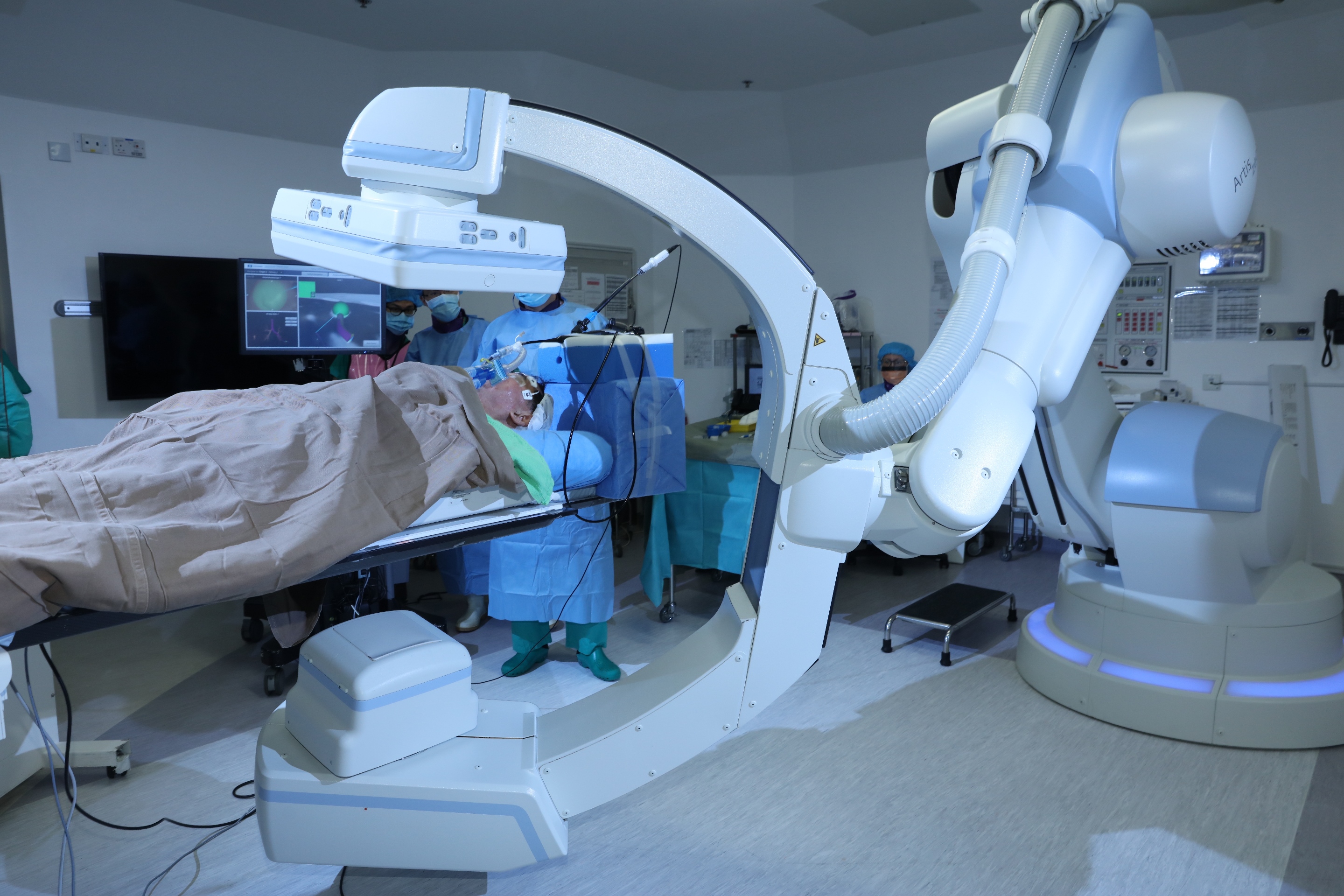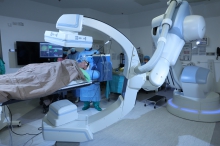News Centre
CUHK Pioneers Early Lung Cancer Treatment with Hybrid Operating Room Image Guided Electromagnetic Navigation Bronchoscopy
To better manage small pulmonary lesions, thoracic surgical professors from The Chinese University of Hong Kong (CUHK) were the first in Asia Pacific region to combine the use of Electromagnetic Navigation Bronchoscopy (ENB) with Hybrid Operating Room since 2015 to allow real-time imaging for surgical localisation and for biopsy. The team has published the world’s first research paper on this surgical approach, allowing significant improvement to accuracy, efficiency and safety. As of now, the thoracic team has helped more than 50 patients to biopsy and the removal of small pulmonary lesions by this technique, of whom over 70% were diagnosed with early lung cancer.
ENB is effective for biopsy of difficult-to-reach lesion
Lung cancer is the leading cancer killer in Hong Kong. According to Hong Kong Cancer Registry, more than 4,000 people died of this disease in 2015.
For pulmonary nodules discovered incidentally by thoracic imaging, such as a chest X-ray or computed tomography (CT), tissue biopsy is needed to further verify if it is a malignant tumour. The method of biopsy depends on the size and position of the lesion.
Dr. Rainbow Wing Hung LAU, Clinical Assistant Professor (honorary), Division of Cardiothoracic Surgery, Department of Surgery, Faculty of Medicine, CUHK, said, “The conventional methods for biopsy such as the percutaneous approach and surgical operation are invasive and have a high risk of complications. Also, there is a limit to the area of the lung that traditional bronchoscopy can reach. ENB is a novel practice developed in recent years for localisation and for biopsy of pulmonary lesions.”
Before performing ENB, doctors conduct a lung CT scan for the patient and input data into the navigation system. The navigation system will then draw a 3D image of the airways structure and plan a route that guides to the target lesion. During the procedure, doctors need to steer the navigation system bronchoscope to locate the lesion, which is similar to a car global positioning system (GPS) unit.
Conventional bronchoscopy usually can only reach the more central parts of the lung, but ENB can go further to the periphery or even the most distal aspects with extremely fine and flexible biopsy tools.
Hybrid Operating Room Provides Real-time Imaging for Precise Localisation and Biopsy of Multiple Small Lesions
Dr. Calvin Sze Hang NG, Associate Professor, Division of Cardiothoracic Surgery, Department of Surgery, Faculty of Medicine, CUHK explained, “Although ENB can locate difficult-to-reach lung lesions, there is often a navigational error of 4-6mm due to limitations in electromagnetic positioning. Such error becomes highly significant when lung lesions are smaller than 1cm in diameter. The combined navigational ability of ENB and imaging capabilities of the Hybrid Operating Room allow more effective and accurate diagnostic biopsy of small lesions. The automated 360-degree robotic C-arm imaging device in the hybrid room provides a reconstructed DyanCT image. It works as a camera capturing real-time images that can instantly be compared with the ENB navigation route, enabling fine readjustments to the direction or depth of the ENB, and hence increases the accuracy of the procedure.”
Conventional ENB performed in the endoscopy suite can locate lesions with a diameter of 10-15mm while those in the Hybrid Operating Room can target multiple lesions, as small as 2-3mm in diameter.
|
|
Conventional ENB |
Hybrid Operating Room ENB |
|
Possible error in location |
4-6mm |
smaller than 1mm |
|
Manageable lesion size (in diameter) |
10-15mm |
2-3mm |
Novel use of Fluorescent Dye-marker enables precise resection of very small lesions
The new technique is also useful in surgical operations for resection of small peripheral lung nodules. After locating the nodule with ENB, surgeons inject dye-marker adjacent to the lesion to make it visible for surgical resection.
Dr. NG added, “The usual dye marker ‘methylene blue’ we have been using is in a blue colour which may look rather similar to discoloured diseased lung tissue. Our team has made use of fluorescent indocyanine green marking together with near-infrared spectroscopy (NIRF) induced images to perform resection more efficiently, especially when using ultra-minimally invasive single-port video-assisted thoracic surgery (SPVATS). This application allows surgeons to locate and remove the lesion with a smaller wound.
Dr. NG, who is also a world pioneer in SPVATS, concluded that the new technique enables biopsy and resection of difficult-to-locate or very small lesions by SPVATS. “Such complex and tailored management of multiple pulmonary lesions, some as small as 2mm, are becoming increasingly important in treatment of early detected cancer and for an ageing population. With the increased accuracy and safety enabled by this set of procedures, the amount of lung tissue resected as well as the potential for complications could be minimised. Patients can benefit from better preserved pulmonary function and speedier recovery.
For patients who are unable to undergo surgery, placement of metal fiducial markers via ENB can assist radiotherapy treatment of the tumour. The CUHK thoracic surgical team is now looking to expand the applications of hybrid operating room image-guided ENB into endoscopic ablation and robotic ENB, with the aim of moving from minimally-invasive to non-invasive surgery for treatment of small lung tumours.
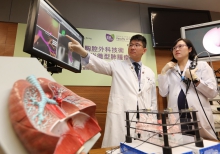
The Faculty of Medicine at CUHK combines the use of Electromagnetic Navigation Bronchoscopy (ENB) with Hybrid Operating Room to allow real-time imaging for surgical localisation and for biopsy of micro pulmonary lesions, some as small as 2mm in diameter. (From left) Dr. Calvin Sze Hang NG, Associate Professor, Division of Cardiothoracic Surgery, Department of Surgery, Faculty of Medicine, CUHK and Dr. Rainbow Wing Hung LAU, Clinical Assistant Professor (honorary) from the same division.

Dr. Rainbow Wing Hung LAU says the Faculty was the first in Asia Pacific region to combine the use of Electromagnetic Navigation Bronchoscopy (ENB) with Hybrid Operating Room since 2015, to allow real-time imaging for surgical localisation and for biopsy of micro pulmonary lesions.

Dr. Calvin Sze Hang NG says the thoracic surgery team has helped more than 50 patients to biopsy and the removal of small pulmonary lesions by this technique, of whom over 70% were diagnosed with early lung cancer.
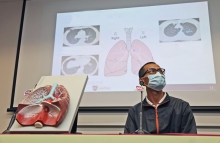
Mr. Au felt discomfort in the chest and sought medical assistance. He initially thought it was linked to the heart but the check-up revealed suspicious small lesions in his lungs. With the new technology, lesions were removed and were proven to be three lung tumours. Due to early discovery, he does not need to undergo chemotherapy or radiotherapy, but only regular check-ups.



